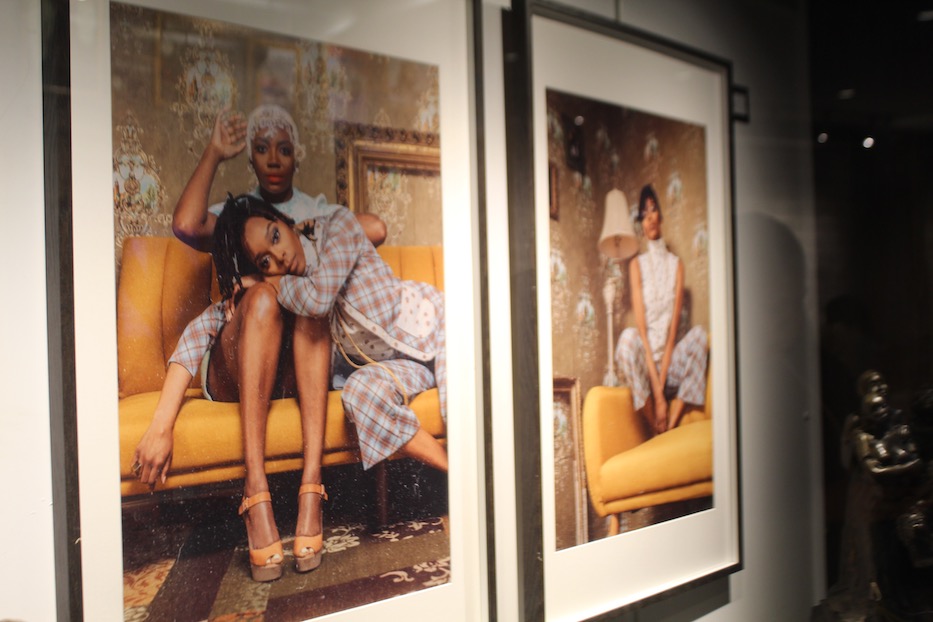
Black History Month | Culture & Community | Southern Connecticut State University | Arts & Culture | History | Arts & Anti-racism
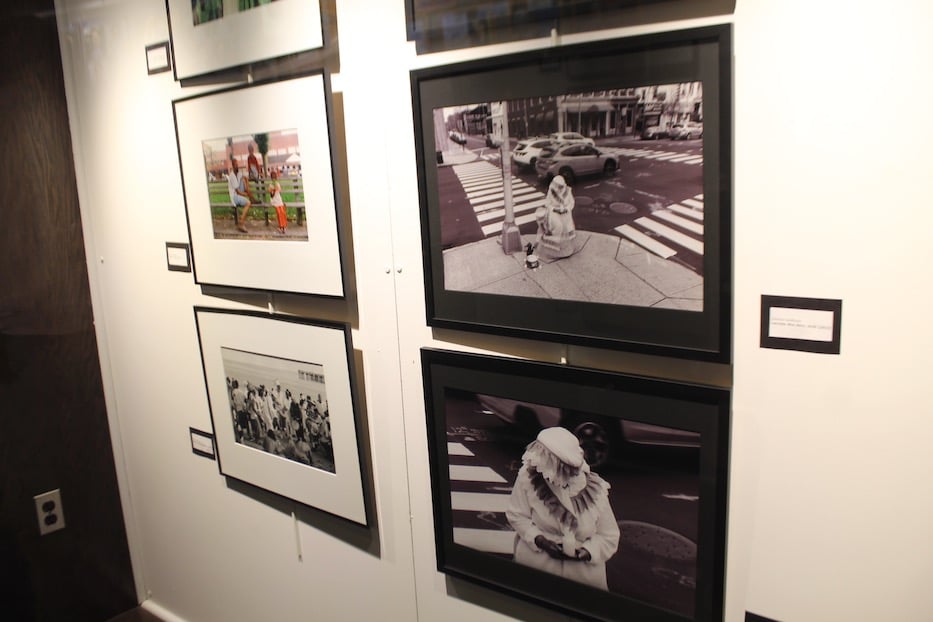
On the left: Jamel Shabazz' "Father's Day" (1990) and "Honoring The Ancestors." Right: Katrina Goldburn's Lucretia Was Here, 1638 series.
The woman sits at the corner of Elm and Orange Streets, her hands wrapped around a candle and its saucer. Beside her, white flowers are still and hushed in a silver bowl; white candles wait unlit nearby. The scalloped edges of a skirt hang over her knees; a matching bonnet covers her forehead. Around her, life continues in the present. Cars speed by, breezing through the four-way crosswalk around them.
But she is there—just as her history always has been—writing herself back into the narrative.
Katrina Goldburn’s series Lucretia Was Here, 1638 is part of Seven Lenses: Documenting Black Culture, running at the John Lyman Center for the Performing Arts at Southern Connecticut State University (SCSU) through March 4. Curated by multi-media artist Shaunda Holloway, the exhibition both captures and pays homage to the breadth of Black life over decades of American history.
Artists include Robert Cooper, Lydia Douglas, Katrina Goldburn, Koren Martin, Ebony McKelvey, Linda Mickens, P.W. Ng’ang’a and Jamel Shabazz. During an opening last Thursday, it doubled as the first event of Southern’s new Minor in Africana Studies, the years-long work of a steering committee helmed by Professors Siobhan Carter-David and Brandon Hutchinson. Carter-David said that it is meant to capture the multiplicity of a diaspora, with courses that range from jazz history to criminal justice.
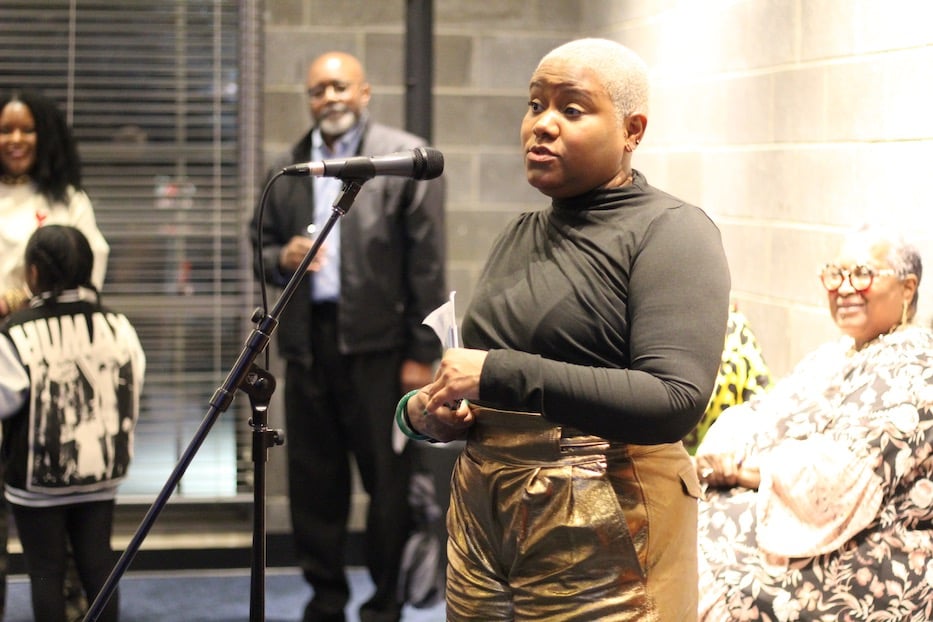
Professor Siobhan Carter-David. Lucy Gellman Photos.
“We wanted to draw from the very diverse Black community that Southern is,” said Carter-David, a professor of history at SCSU, shouting out her collaborators in the audience. “The diaspora is here on campus, and so we are trying to really curate all of our talent and our knowledge and our resources to provide an amazing program and curricula for Africana studies … we’re not just creating a minor. We’re trying to build community.”
The exhibition, very much a testament to that community, has been years in the making. Four years ago, Holloway worked with Carter-David on 1619: Southern Remembers The 400th, an exhibition held during SCSU’s commemoration of the first documented instance of chattel slavery in what is now recognized as the United States. The two clicked: Holloway remembered coming away from that experience thinking, “I have to work with her again.”
On campus, Carter-David and her colleagues were building out the new minor course by course (it launched last fall, with an Introduction to Africana Studies that she and Hutchinson co-taught). Off of it, Holloway continued to grow her artistic and curatorial footprint. As the two kept talking about a future collaboration, the name Seven Lenses came up. It stuck.
“The purpose behind Seven Lenses would be to document moments in time from the perspective of each person,” Holloway said Thursday, thanking all seven artists for trusting the process. “A sculptor. Photographers. Each person creates something based on what they see. And artists teach people how to see.”
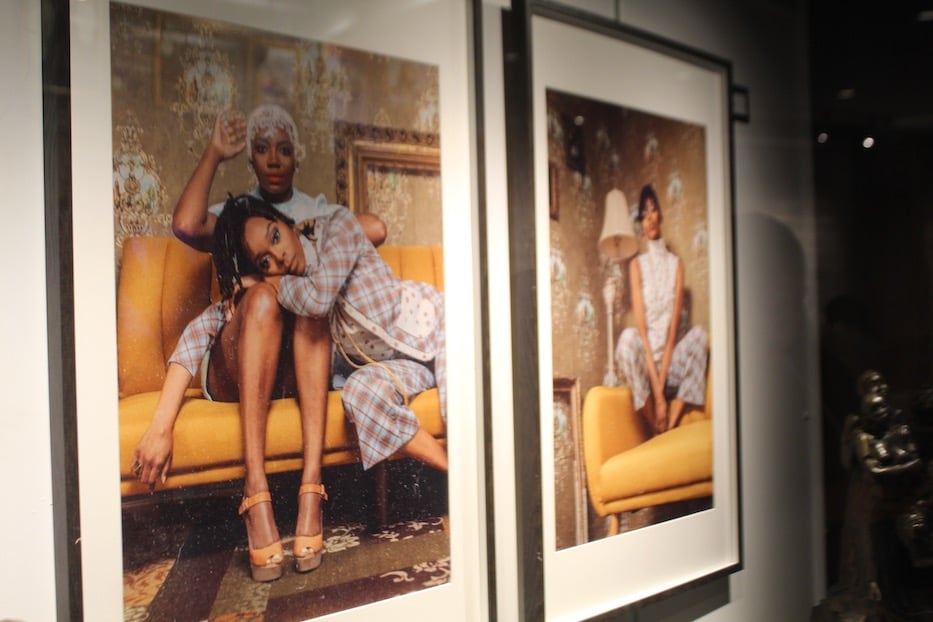
Two prints from McKelvey’s 2021 exhibition Sisterhood: What Once Was feature in the show.
Across the Lyman Center’s open lobby, Holloway and the seven artists have done just that. Beside the large double doors of the Lyman Center’s auditorium, two photographs from McKelvey’s 2021 exhibition Sisterhood: What Once Was look out onto the space in a riot of texture and color, heavy on blues, tans, whites and oranges. It is at once intimate and posed enough to feel crisp, cinematic.
In one image, two models look out at McKelvey, their eyes magnetic. One raises her head, her hand brushing a flapper-era cap festooned with white pearls. The other lays across her lap, one hand on her sister’s thigh as the other arm stretches out, dangling beneath the edge of the couch. If a viewer leans in close enough, they can almost hear the shutter click gently, like the delicious exchange of a secret.
It feels like the image could have been taken in the 1920s or the 2020s or anywhere in between, unfixing the viewer and subjects alike in space and time. Around the two women, patterns explode in color: the blue-and-orange tweed of a model’s suit, the pearls and lace of the hat, a dotted silky blouse underneath. Behind them, the tamarind-colored wallpaper is printed with chandeliers. Beneath them, two of Mickens’ sculptures look out at the viewer, their bodies forever intertwined.
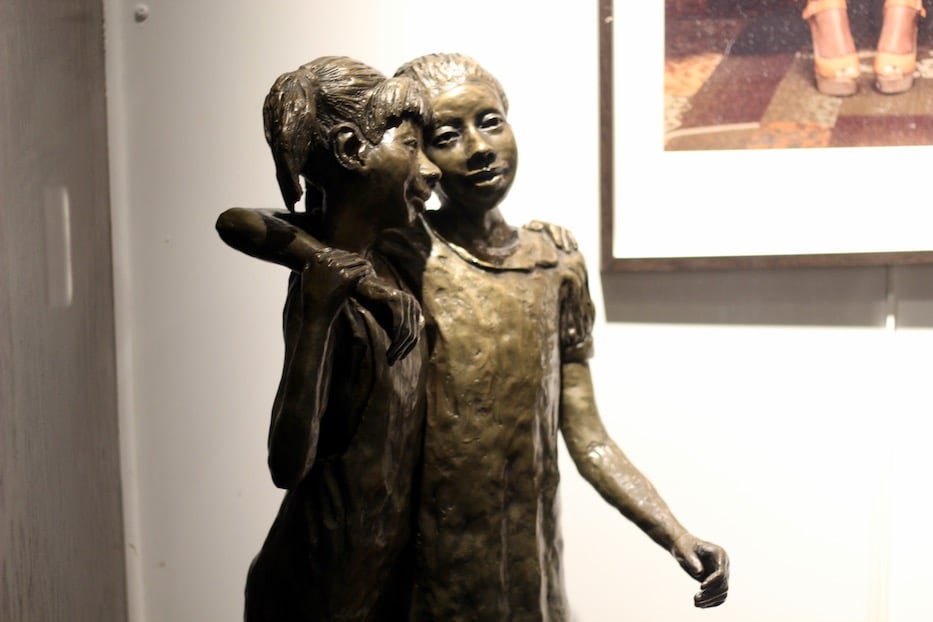
Detail, Linda Mickens' Two Girls Hugging.
In this sense, it feels like both a reminder and a reclamation. Black women have always been part of the historical and visual record, just as they have been at the forefront of American history. And at the same time, misogynoir is very real: they are more likely to be erased from the narrative than both their white and their male counterparts. There’s a reason people know the name James VanDerZee before Florestine Perrault, and Irving Penn before both of them.
That same thread—and the fact that racism permeates the history of photography itself—pushed McKelvey into photography years ago. Growing up, “there’s no pictures of me as a child,” she said at the opening last Thursday. As a kid, her peers also teased her for her appearance, from the way she looked to the clothes she wore. When she picked up a camera and fell in love with photography, she realized that she could flip the script. As she has become a mother herself, she’s deepened that commitment.
“I didn’t feel special, I didn’t feel beautiful,” she said, her arms resting on her daughter’s shoulders. “Most of my work is of Black women. It’s to empower Black women, for them to see their true beauty. No, they’re not dressed in regular clothing, because I don’t want them to feel regular. I want them to feel unique with my pictures. I want them to feel inspired. I want them to feel that, ‘Yes, I can look that way as well.’”
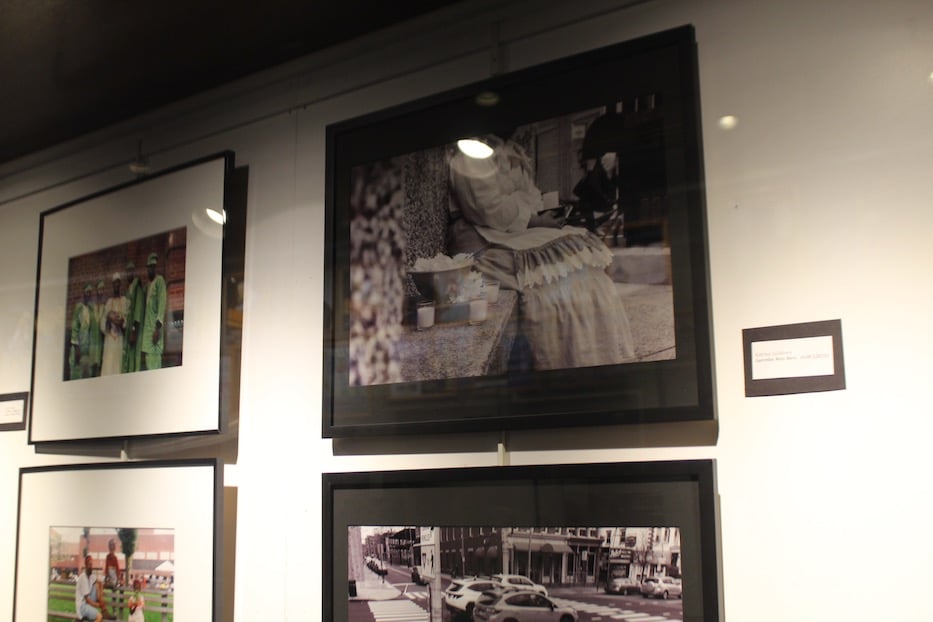
Left: Jamel Shabazz' "It Takes A Village," photographed in North Philadelphia in 1994. Right: Photographs from Katrina Goldburn's Lucretia Was Here, 1638 series.
In the display case beside McKelvey’s photographs and Mickens’ sculptures, Shabazz’ documentation of Black family life in New York and Philadelphia stays with a viewer. In Shabazz’ “It Takes A Village to Raise A Child,” shot in North Philadelphia in 1994, a groom and his four groomsmen look out proudly, a father cradling his newborn son at the center.
Dressed in white and gold, he has a smile that beams out toward every corner of the frame. Beside him, the green and silver fabric of his groomsmen’s dashikis grows in the sunlight. For a moment, it feels that all is right with the world—that this young man, and his young man, are so very loved and supported. Behind them, an exposed, red brick wall rises toward the sky.
There’s a moving sense of both Black legacies—of rite and ritual—and Black futures. The image was shot in Philadelphia in the 1990s, but feels like it could have been somewhere in New Haven last week. Beneath them, Shabazz’ 1990 “Father’s Day,” photographed in Brooklyn, continues the narrative.
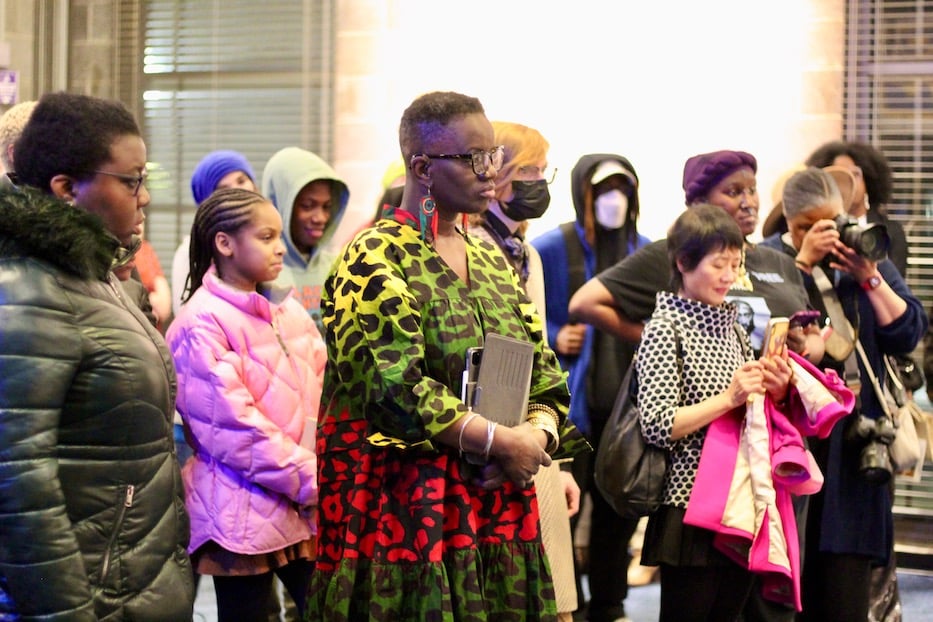
Curator Shaunda Holloway: "Artists teach people how to see.”
So too Goldburn’s series Lucretia Was Here, 1638, stacked in a column of three black-and-white prints next to them. Completed this year, the works pay homage to Lucretia, now believed to be New Haven’s first Black resident in the first half of the 17th century. Across three images, Lucretia—the model for whom is Goldburn’s mother—stands at the corner of Orange and Elm Streets, surrounded by white flowers, candles, a tall black tea kettle with a spout pointed toward the sidewalk. That corner marks where she was once enslaved by Theophilus Eaton, binding past and present as traffic sails by.
When she started on the project earlier this year, Goldburn said she was especially inspired by the research of Dr. Ann Garrett Robinson, a writer and retired professor of psychology who discovered Lucretia’s name a quarter of a century ago, and has become her greatest living champion in the years since. Goldburn, who said she took a break from photography after documenting years of protest against police brutality, was inspired by Lucretia’s story.
“This is a perfect opportunity to educate us, to educate myself,” Goldburn said Thursday. “This is local history, which I do love. It’s art.”
The history is living history, she added. In the past several years, Robinson has worked with former Alder Steve Winter to advocate for a corner named in Lucretia’s honor. Last year, the city’s Board of Alders voted unanimously to approve the request. That naming will take place on Feb. 27, just before the end of Black History Month.
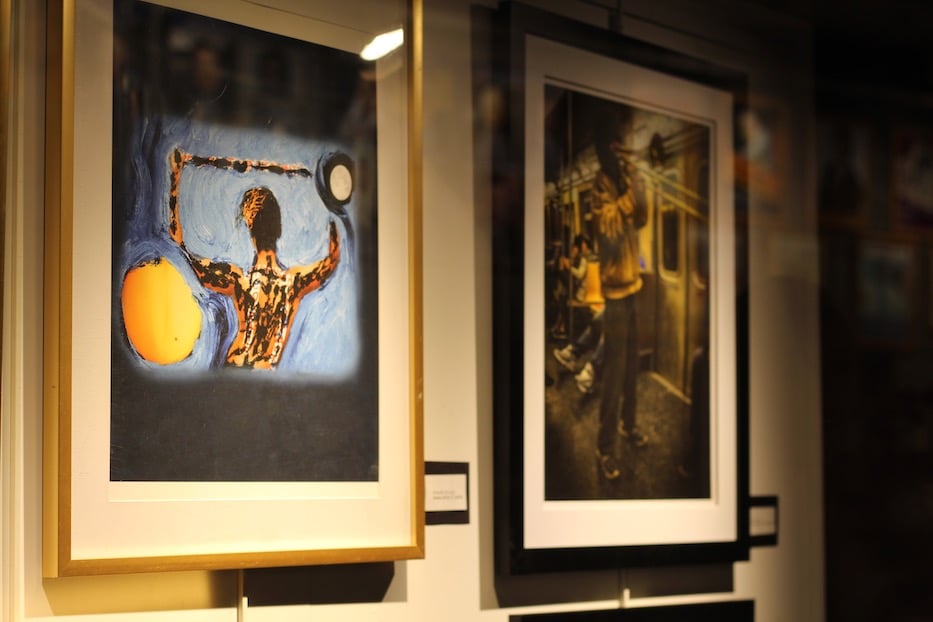
P.W. Ng’ang’a's "Seasons VII by P." (2019) and Koren Martin's "Blues on the A Train" (2017).
Across the lobby, the works of Cooper, Douglas, Ng’ang’a and Martin grow that story with portraits that at once bear witness and celebrate space and craft. Some of the only mixed media work in the show, pieces from Ng’ang’a’s Seasons series seem to speak directly to Martin’s photographs, outdoor portraits of musicians that are presented in highly saturated color. The interplay between Douglas and Cooper’s work is also particularly rich, simply because their lenses are so different.
In works like Douglas’ “Lauren and Jordan,” a close-up portrait of a mother and her young son, Douglas trusts her viewer with this tender moment, freezing time as they sit back to back, neither looking at the photographer. The two are completely comfortable with each other; Lauren’s mouth opens just slightly, showing the row of teeth in between; she pulls her knees unhurriedly into her chest. A necklace forms an inverted V on the nape of her neck.
Jordan, his eyes soft, looks pensive beside her. His head leans gently against the chain link fence. He is so young, in a still frame of boyhood that feels weighted, precious, fleeting.
The sense of timelessness—that this could be 2022 New Haven, or 1995 New York, or 1980s Philadelphia on a sticky summer day—lives right alongside the specificity of the image. Douglas has done what so many photographers do not: she has taken the time and intention to learn who her subjects are, and asks the viewer to do so too.
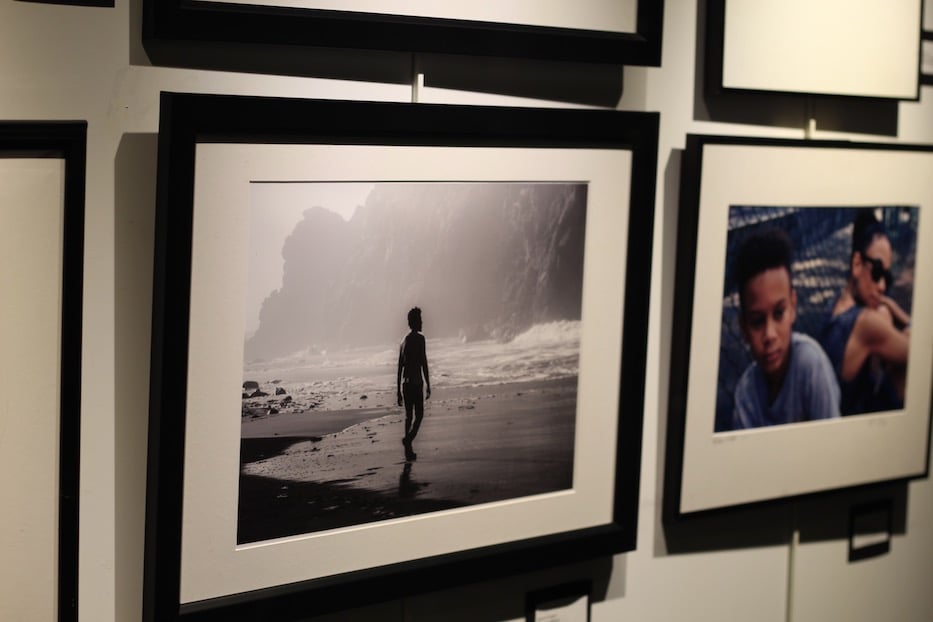
Robert Cooper's image of Tarishi Shuler photographed on Pfeiffer Beach in Big Sur, California, with Lydia Douglas' "Lauren and Jordan."
Beside it, Cooper’s photographs from mountain climbing in Meriden and Pfeiffer Beach in Big Sur, California feel monumental, despite a size and scale that requires proximity from the viewer. In one, a model sits in a full suit at the edge of a cliff, relaxed as the whole wide skyline spreads around him. In another, the size of Big Sur dwarfs poet and spoken word performer Tarishi Midnight Shuler, who walks along the sand as surf crashes into the rocks and shore.
Even in black and white, the wet sand glistens, silken and indented beneath his feet. Here, in real time, is an antidote to the overwhelming Caucacity of nature photography and photographers, from Ansel Adams to the latest issues of R.E.I. and Eddie Bauer.
In this sense, Holloway is a masterful curator: she has a keen sense of how images share space with each other, and together create a dialogue that is so much bigger than the work of any one artist. That skill is especially true in the lobby of the Lyman Center, where Holloway has given visitors a reason to look closely and linger in a space that was built to pass through.
“Art Is A Pathway To Healing”
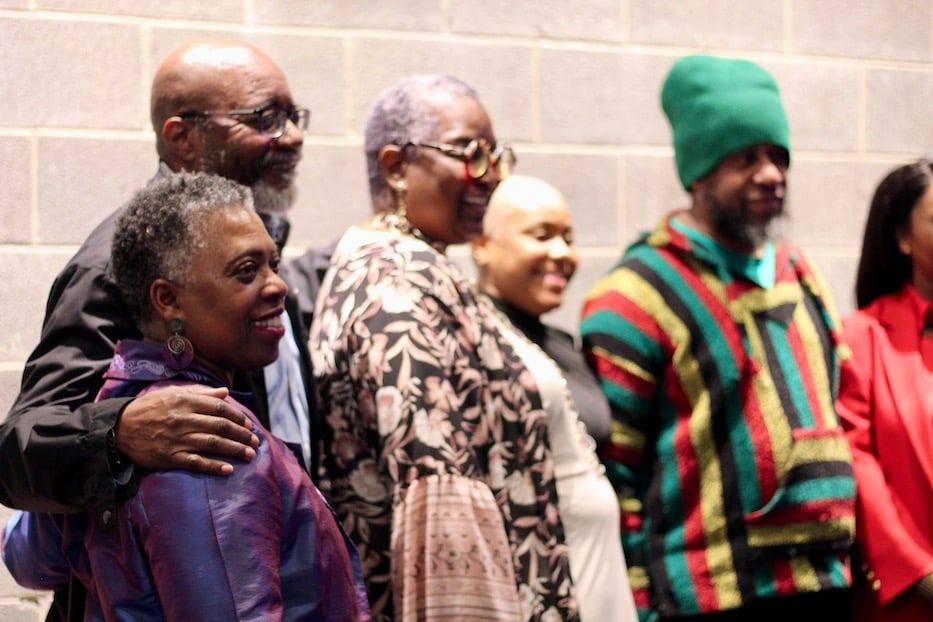
Douglas (in purple): " I capture us being people, because the media doesn't show us as who we are." Lucy Gellman Photo.
At an exhibition opening last Thursday night, several of the featured artists also gave insight into the work that they submitted, from intimate portraits of Black couples and families to sisters cast in bronze, forever frozen in a young and sweet embrace. Babz Rawls-Ivy, who emceed the event, noted that the works let a viewer see the world as what it could be, rather than what it is.
“Listen, our country is in the midst of some—whatever we are doing,” she said. “But I do know that art is a pathway to healing and understanding. That you can go and sit with a piece of artwork and imagine what the world could be.”
Many of the artists echoed that throughout the evening. Mickens, whose bronze sculpture Two Girls Hugging pulls a viewer into the space and keeps them there, said that she sees her work as part of an "art spirit" that moves her to create. Decades ago, her foray into sculpture began under the guidance of sculptor and professor Grigory Gurevich in New Jersey.
In addition to bronze, she works with paper and recycled materials, including in a group show currently running at Creative Arts Workshop. While she may be best known for her series Everyday Angels, she said, the sculptures in Seven Lenses reflect her earlier work.
"I think that art motivates," she said. "it activates. Cause I consider myself now an art-activist."
"An artivist!" yelled Elm City LIT Fest Founder IfeMichelle Gardin. Attendees cheered.
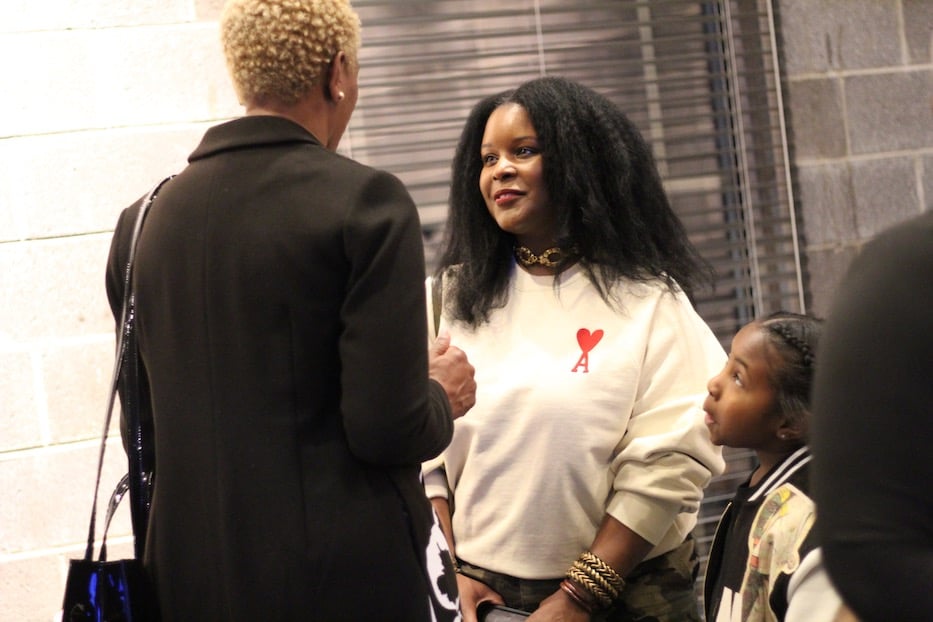
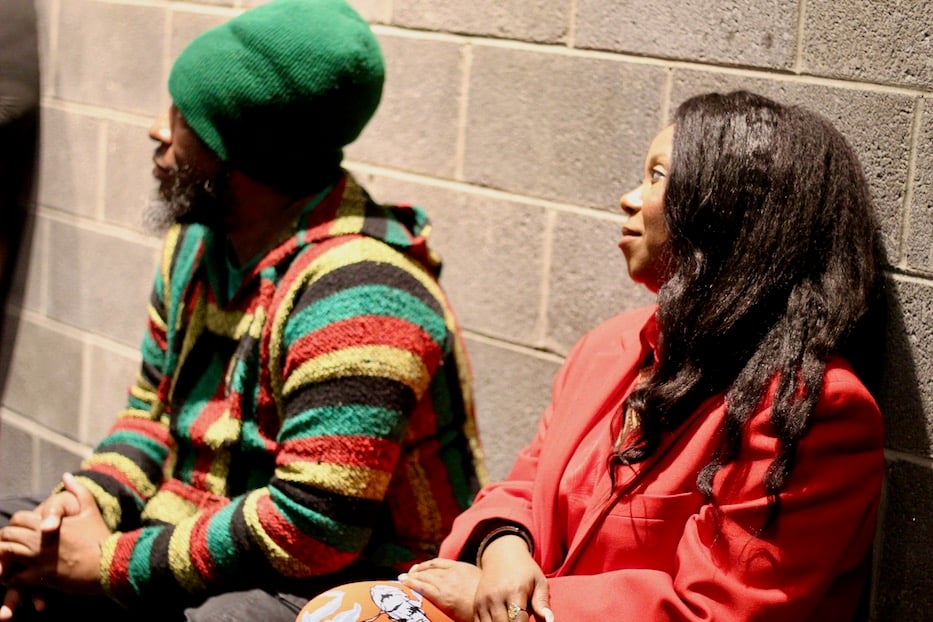
Top: Ebony McKelvey. Bottom: Robert Cooper and Katrina Goldburn.
Douglas, a filmmaker and photographer whose works are simultaneously intimate and open, said that part of her work is showing her subjects' humanity. As she spoke, her portraits looked back onto the lobby from a nearby wall, where they were framed and enclosed inside a display case. They were tender: a snapshot of maternity, and above it, a still, black-and-white frame of Black love.
The child of two artists, Douglas started her career with the intention of becoming a fashion designer. The only problem, she said to laughs, was that she hated drawing—an essential part of design. Then her first year of college, a photography class changed her life. She described film, particularly black-and-white film, as her "first love."
She noted how often, and for how long, the mainstream media has failed to paint a full and genuine portrait of Black Americans. In her work, she actively counters that narrative every time she takes a photo. While some of her portraiture is posed, much of it takes place out in the world, as she documents her surroundings in real time.
"What makes me take the picture is definitely melanin," she said. "I'm definitely stimulated by Black people. I can take a picture of anyone, and make anybody look good, but what really, really moves my heart are Black people. A lot of children. A lot of women and children. And I capture us being people, because the media doesn't show us as who we are."
"We're brilliant. We're angry sometimes. We're kind. We're loving. We're just like regular human beings. And that's what inspires me to take pictures."
Seven Lenses: Documenting Black Culture runs at the John Lyman Center for the Performing Arts at Southern Connecticut State University (SCSU) through March 4. Learn more about the Lyman Center, including how to visit, here.

